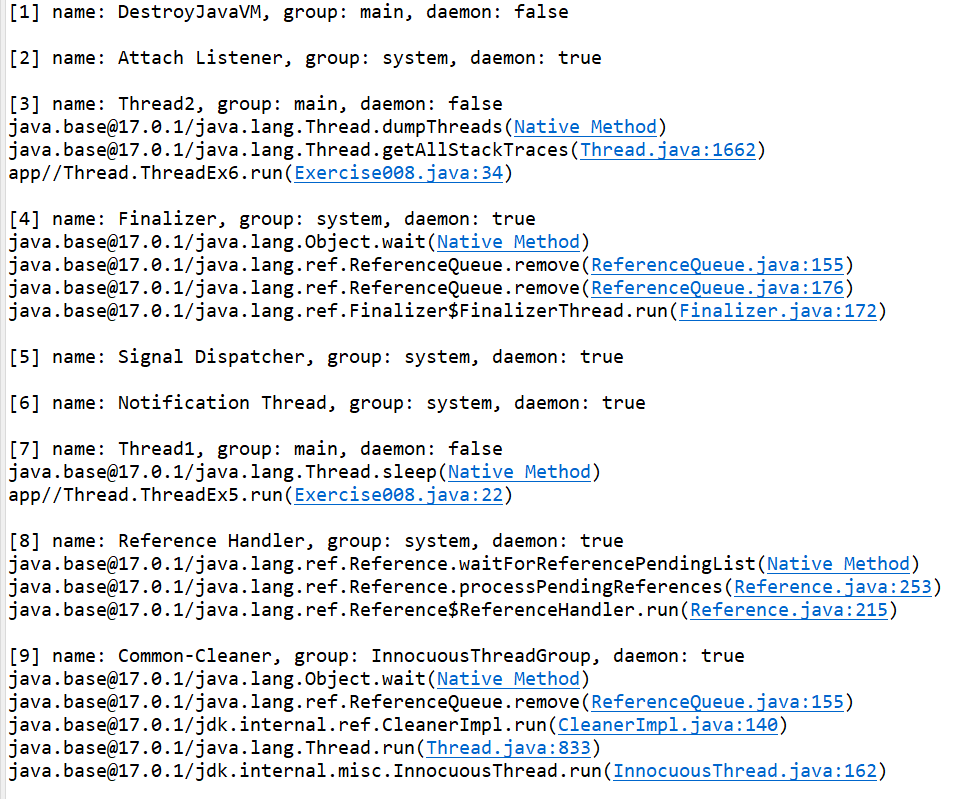1. 데몬 쓰레드에 대한 기본 개념
- 데몬 쓰레드는 다른 일반 쓰레드의 작업을 돕는 보조적인 역할을 수행하는 쓰레드이다.
- 일반 쓰레드가 종료되면 데몬 쓰레드도 강제적으로 종료되는데, 그 이유는 일반 쓰레드를
보조 역할로 수행하는데 없으면 있을 이유가 없기 때문이다.
- 데몬 쓰레드의 예로는 가비지 컬렉터, 워드프로세서의 자동저장, 화면자동갱신 등이 있다.
- 데몬 쓰레드는 무한 루프와 조건문을 이용해서 실행 후 대기하고 있다가 특정조건이 만족되면
작업을 수행 후 다시 대기한다.
- 데몬 쓰레드는 일반 쓰레드의 작성방법과 실행방법이 같으나, 쓰레드를 생성한 다음 실행하기 전에
setDaemon(true)를 호출해주어야 한다.
- 데몬 쓰레드가 생성한 쓰레드는 자동적으로 데몬 쓰레드가 된다.
2. 데몬 쓰레드를 이해하기 위한 예제(1)
: 데몬 쓰레드가 어떻게 돌아가는지 알아보는 예제이다.
import java.util.*;
public class Exercise007 implements Runnable{
static boolean autoSave = false;
public static void main(String[] args) {
Thread t = new Thread(new Exercise007());
t.setDaemon(true);
t.start();
for(int i=0; i<=10; i++) {
try {
Thread.sleep(1000);
}catch (Exception e) {
// TODO: handle exception
}
System.out.println(i);
if(i==5) autoSave = true;
}
System.out.println("프로그램을 종료합니다.");
}
//쓰레드가 무한반복중인데, 데몬쓰레드로 설정했기 때문에 종료가 된다.
@Override
public void run() {
while(true) {
try {
Thread.sleep(3*1000);
System.out.println("----------------");
}catch (Exception e) {
// TODO: handle exception
}
if(autoSave) {
autoSave();
}
}
}
public void autoSave() {
System.out.println("작업 파일이 저장되었습니다.");
}
}
( 여기서 보면 데몬 쓰레드는 while(true)로 무한 루프를 가지고 있는데, 만약 이것이 일반
쓰레드라고 가정하면 영원히 안 멈출 것이다. )
( 그러나 데몬 쓰레드로 setDaemon(true)을 해주었기 때문에 main이 종료되니 같이 끝나게
되었다. )
( 또한 setDaemon(true)을 start()전에 출력하지 않으면 IllegalThreadStateException이 발생한다. )
3. 데몬 쓰레드를 이해하기 위한 예제(2)
: getAllStackTraces()를 이용하면 실행 중 또는 대기상태와 같이 작업이 완료되지 않은 모든 쓰레드의
호출스택을 출력할 수 있다.
import java.util.Iterator;
import java.util.Map;
import java.util.Set;
public class Exercise008 {
public static void main(String[] args) {
Thread t1 = new ThreadEx5("Thread1");
Thread t2 = new ThreadEx6("Thread2");
t1.start();
t2.start();
}
}
class ThreadEx5 extends Thread{
public ThreadEx5(String name) {
super(name);
}
public void run() {
try {
Thread.sleep(5*1000);
}catch (Exception e) {
// TODO: handle exception
}
}
}
class ThreadEx6 extends Thread{
public ThreadEx6(String name) {
super(name);
}
public void run() {
Map map = getAllStackTraces();
Iterator it = map.keySet().iterator();
int x=0;
while(it.hasNext()) {
Object obj = it.next();
Thread t = (Thread) obj;
StackTraceElement[] ste = (StackTraceElement[]) (map.get(obj));
System.out.println("["+ ++x + "] name: " + t.getName()
+ ", group: " + t.getThreadGroup().getName()
+ ", daemon: " + t.isDaemon());
for(int i=0; i<ste.length; i++) {
System.out.println(ste[i]);
}
System.out.println();
}
}
}

( 총 9개의 쓰레드를 가지며, 대부분 system, main 쓰레드의 그룹을 가진다. )
'자바 > 프로세스와 쓰레드' 카테고리의 다른 글
| 쓰레드의 동기화(1): Critical Section & Lock, snychronized (0) | 2022.05.07 |
|---|---|
| 쓰레드의 실행제어 (0) | 2022.02.20 |
| 쓰레드의 우선순위와 쓰레드 그룹 (0) | 2022.02.14 |
| 싱글쓰레드와 멀티쓰레드 (0) | 2022.02.14 |
| 쓰레드의 기본적 구현과 실행 (0) | 2022.02.14 |
